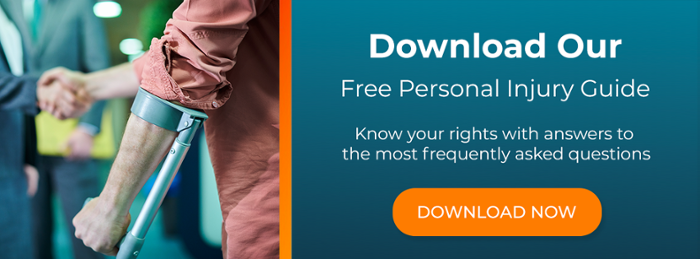https://youtu.be/QhdloZUh7_w
You may have a chance to seek funds for your financial losses if you sustained injuries in an accident in Austin, Texas. Generally, you can proceed with a legal claim if someone else caused your injuries through negligence or intentional wrongful acts.
You can contact an Austin personal injury lawyer as soon as possible to discuss your case. Our team at Zinda Law Group can help you learn more about personal injury laws in Austin. We can handle many cases, providing you with personalized attention.
If you have been involved in an accident and believe another person or entity was negligent or acted intentionally, call our Texas personal injury lawyers for your 100% free consultation. You will not pay us anything unless we successfully win your case.
Free Consults24/7
Send Request NowWhat Personal Injury Cases do We Handle in Austin?
The Austin personal injury attorneys at Zinda Law Group have years of experience handling, settling, and litigating personal injury cases. Some of the most common personal injury cases we handle include:
- Car accidents
- Truck accidents
- Motorcycle accidents
- Dog bites and animal attacks
- Wrongful death
- Workplace accidents
- Product liability
- Slip and fall accidents
- Pedestrian accidents.
Our team has extensive experience handling many different kinds of cases and has helped countless individuals pursue the maximum amount of compensation available in their cases. See our client reviews and testimonials for more information.
We understand personal injury cases in Austin, TX, and we’re ready to put our training to work for you. We work aggressively to support you while providing the compassionate attention you need after an accident.
For a free legal consultation with a personal injury lawyer serving Austin, call 800-863-5312
 Can You File a Personal Injury Claim in Austin?
Can You File a Personal Injury Claim in Austin?
Austin personal injury cases allow you to legally settle disputes after you experience injuries due to another person’s actions. The courts in Austin can hold the person who caused your injuries liable for their accidental or intentional actions.
Generally, the party that caused a dangerous accident has to cover your losses by providing you with compensation. However, you may only receive payment if your Austin personal injury attorney shows that:
- Someone owed you a duty of care
- The individual violated their duty to you
- The individual’s actions directly caused your injuries
- You sustained some kind of financial loss due to your injuries
Our team can initiate and handle personal injury claims on your behalf in Austin, TX. We can represent you in and out of the civil court system and have the experience and confidence to handle severe accidents.
Personal Injury in Austin lawyers near me 800-863-5312
How does a Personal Injury Lawsuit Work in Austin?
Personal injury lawsuits in Austin, TX, generally require your lawyer to gather evidence to support your claim. Your lawyer will then file the appropriate paperwork, which may result in a civil trial.
We handle all aspects of your trial, using evidence to show that another individual caused your injuries and losses. You may receive a jury verdict in your favor. However, in many cases, your lawyer may suggest that you settle with the insurance company out of court.
The settlement process involves back-and-forth negotiations between those personally involved in the dispute, their insurers, and attorneys representing both sides. A personal injury lawyer in Austin, TX, may be able to help you determine the best path forward.
Click to contact our Texas Personal Injury Lawyer today
What Damages Are Available to Personal Injury Victims in Austin?
Compensation in Austin personal injury cases generally comes in two forms. Your Austin personal injury lawyer could help you secure:
Economic Damages for Austin Accidents
Economic damages have a straightforward numerical value. These damages come directly from your accident and obviously impact your life. Examples of economic losses can include your:
- Austin healthcare expenses
- Pharmacy bills after an accident
- Costs for rehabilitation and physical therapy
- Lost income and diminished earning capacity
Generally, lawyers collect bills issued to you after an accident to track and calculate your economic damages in Austin.
Non-Economic Damages for Austin Accidents
Non-economic damages in Austin require more complicated calculations. These subjective damages may not have a direct dollar value after your accident. Non-economic losses often include:
- Your pain and emotional suffering
- The effects of a disability caused by your accident
- The effects of disfigurement
- Loss of consortium in Austin
Your Austin personal injury lawyer can help you learn more about non-economic damages and how they apply in your case.
Punitive Damage for Austin Accidents
Finally, you may receive punitive damages after an accident in Austin. The court generally awards punitive damages if the individual at fault for your wreck behaved very recklessly or caused the accident intentionally.
Our team takes a lot of pride in assisting clients to secure all possible compensation after an accident.
Our attorneys will fight to protect your rights, ensuring you are compensated for the totality of your economic and non-economic damages. For more information, review our case results. You can start working with an Austin personal injury lawyer today.
Free Consults24/7
Send Request NowComplete a Free Case Evaluation form now
Why You Need an Austin Personal Injury Lawyer
After being injured in a car accident, work-related accident, dog attack, or similar situation in Austin, it is essential to contact an experienced personal injury lawyer.
The right Austin personal injury attorney can help you pursue the maximum compensation for your injuries or property damage by investigating your case, determining fault, dealing with insurance companies, and fighting on your behalf before a judge if a favorable settlement cannot be made.
Our team has ample experience in personal injury cases in Texas. Call Zinda law group today to discuss your claim and why you may need an Austin personal injury attorney to represent you in your specific case.
Why Choose Zinda Law Group After an Accident?
You may wonder why you should choose Zinda Law Group attorneys to represent you in your personal injury case. Zinda Law Group’s personal injury attorneys offer years of experience navigating personal injury cases to help protect our client’s rights.
Let us work for you while you work on recovering from your injuries. Additionally, we provide top-notch client service, better business bureau accreditation, litigation-focused representation, experienced negotiators, and a no-win, no-fee guarantee, where you pay nothing unless we win your case.
Zinda Law Group attorneys hang their hats on their ability to provide exemplary service to clientele. Thus, if you have been injured, contact our team as soon as possible. We can help investigate your accident and give your case the attention it deserves while you focus on your recovery.
What Should You Do After an Accident in Austin?
Although each case is different, you can do certain things or steps to maintain your physical well-being while preserving or aiding your future personal injury lawsuit in Austin. These steps include:
Seeking Care for Your Injuries
We encourage you to seek medical treatment for any injuries you sustained in an Austin accident. You may require emergency care, or you may only notice your injuries a few hours or days after the incident.
Getting care quickly can improve your recovery and demonstrates that the accident directly caused your losses.
Reporting Your Accident
Ensure that you report the accident quickly. You may have to report a motor vehicle accident to the police, for example. However, you do not have to notify the police after every Austin Accident.
For example, if you slipped and fell in a department store, report the accident to a manager or store owner and get a copy of the accident report. Find out more about these reports with an Austin personal injury lawyer.
Documenting Your Austin Accident
Generally, the professionals recommend that you keep track of all paperwork and evidence related to your accident. We can organize and track this information on your behalf.
You can also collect evidence on behalf of your lawyer in some cases. For example, you can take pictures of the accident scene and your injuries after an accident.
Your Austin personal injury attorney may use the information you gather to build your case.
Speaking with an Austin Personal Injury Lawyer
You can discuss your case with a personal injury attorney in Austin, TX, to get more guidance about your next steps.
Plus, you will want to work with someone nearby who can keep you updated on the status of your case and who is available 24/7 to answer your questions.
Call Zinda Law Group today to discuss your case and answer any questions you have regarding what you should do following an accident.
CASE RESULTS
Why It’s Important to Act Quickly If You Have a Personal Injury Claim
If you think you may have a personal injury claim, it is essential to act quickly for several reasons, including:
- The statute of limitations
- The availability of evidence
- The predatory practices of insurance companies
Texas Statute of Limitations
Personal injury claims in Austin are governed by the Texas statute of limitations. The statute of limitations tells you how long you have to bring a suit against another party. In Texas, the statute of limitations for personal injury cases is typically two years from the date of the injury.
However, there can be exceptions to this rule, so it is always smart to consult an attorney. An experienced personal injury lawyer can review your case and determine the deadline that applies to you.
Evidence Disappears
It’s crucial to act quickly because evidence that can help prove your case has a tendency to disappear over time. Things get lost. People or witnesses move away, forget important details or even pass away. A personal injury attorney can help ensure you collect all the critical pieces of evidence for your case as soon as possible.
Insurance Companies
Most personal injury lawsuits look to collect damages from the insurance company of the person who caused the harm. Insurance companies are businesses with shareholders, and they try as hard as they can to avoid paying out settlements because it impacts their financial bottom line.
If you delay hiring a personal injury attorney, you could be giving the insurance company more time to get their defensive strategy in place, which reduces the likelihood of the best possible settlement.
What Is Comparative Negligence in Austin, Texas?
Another critical concept to understand within your personal injury case is comparative negligence. Generally, when claiming comparative negligence, the defendant alleges both parties were at fault for the accident.
The state of Texas practices proportionate responsibility, in which a claimant cannot recover damages if their percentage of fault in the accident is greater than 50%. Juries typically weigh the testimony and evidence to assign each party’s responsibility percentage.
If you have any other questions regarding comparative negligence or any other concerns involving your case, contact an Austin personal injury attorney today.
What do Personal Injury Lawyers Charge in Austin?
Generally, firms handle Austin personal injury claims on a contingency basis, meaning they only charge legal fees after resolving the claim. Therefore, you can get help from an Austin personal injury lawyer without straining your finances.
We can answer more questions about how we handle these claims when you contact us for assistance.
How Long does It Take to Settle a Personal Injury Claim in Austin?
The amount of time it will take to settle a personal injury claim in Austin will depend on the facts of your case. For example, a simple car accident may take a few months, whereas a complicated wrongful death lawsuit may take several years.
Certain factors that may affect the timeline of your case include the extent of your injuries, the availability of witnesses, and your share of liability.
Zinda Law Group attorneys have ample experience in several different personal injury claims. For more information, review our case results or contact us today. We have Austin personal injury lawyers available 24/7 to take your call and schedule your free initial consultation.
Common Types of Personal Injury Cases in Austin
At the Zinda Law Group, we help with all kinds of personal injury cases. Whatever damages you suffered as the result of an accident, we can help you recover the compensation you deserve.
Austin Bike Accidents
Bicycle accidents can take a number of different forms. While riding your bike in Austin, you could be injured by a collision with a car, a truck, or even another bicycle. If someone has acted in a way that caused your injuries while riding a bike, we can help you understand your rights and figure out what damages you may be entitled to claim.
Austin Car Accidents
Our attorneys know the city of Austin. They understand the complexities of car accidents that can involve drivers from Texas and surrounding states. They understand how to handle cases involving uninsured motorists and other unique scenarios that can be common in Austin.
Austin Premises Injuries
Premises cases involve an injury to a person on someone else’s property. These can happen in hundreds of different ways but often take on the form of a slip and fall case, falling merchandise at a store, trip and fall cases, and injuries that occur at a hotel or some other property owned by a business that has a duty to keep you safe.
Austin Motorcycle Accidents
Motorcycle accidents in Austin are also unfortunately common. Motorcycles can be difficult for drivers to see and offer much less protection than a standard passenger vehicle.
Austin Pedestrian Accidents
Pedestrians in Austin are susceptible to all sorts of hazards in the streets. Whether it be cars, bicycles, or even electronic scooters, pedestrians are not exempt from road injuries just because they may not be operating a motor vehicle.
Austin Truck Accidents
Trucking accidents are some of the more complex personal injury cases. Austin, being uniquely situated as a central hub in Texas, sees a lot of trucks passing through on the roadways. If you’ve been injured in a truck accident, it’s crucial that you call a personal injury attorney quickly.
Large trucking companies have the resources to act fast in order to protect themselves in the event that a truck injured someone.
Austin Wrongful Death Cases
Wrongful death cases are the hardest for all parties involved because there is nothing worse than losing a loved one. On a positive note, these are the cases where we know we can make the biggest difference for our clients.
Of course, no one can return your loved one to you after a wrongful death. However, we can help navigate these complex cases, get you the justice you deserve, and make sure that something like this never happens again.
Austin Dog Bite and Animal Attack Cases
If you or a loved one has been attacked by a dog or other animal belonging to a neighbor, you may be entitled to compensation for your injuries. This is especially true if the pet owner knew the pet had a tendency to attack people and the owner failed to adequately restrain their pet.
Common Injuries in Personal Injury Cases
Unfortunately, injuries occur at a high rate and can come in a variety of forms. Common injuries we see at our firm include:
- Broken bones
- Traumatic brain injuries (concussions or other head injuries)
- Whiplash
- Lacerations, cuts, or wounds
- Spine injuries
- Bruising
- Chronic pain
- Burns
- Birth injuries
- Surgical errors
Austin Resources
Contact an Experienced Austin Personal Injury Attorney Today
At Zinda Law Group, our Texas personal injury attorneys have helped thousands of injury victims recover the compensation they deserved under the law. We have the knowledge and resources to help you build your case against the defendant and pursue maximum recovery for medical bills, property damage, lost wages, pain and suffering, and much more.
Our firm also operates on a contingency fee basis, which means you pay nothing unless we achieve a favorable settlement, judgment, or verdict for your personal injury case. That’s our No Win, No Fee Guarantee.
Give us a call, use our chat tool, or complete our online contact form today to receive your 100% free consultation with one of our experienced Austin personal injury lawyers.
Call or text 800-863-5312 or complete a Free Case Evaluation form


 Can You File a Personal Injury Claim in Austin?
Can You File a Personal Injury Claim in Austin?
























